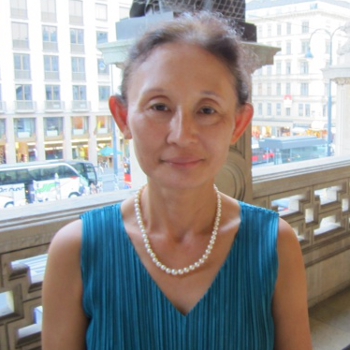In Siegfried, Guy Cassiers achieves a stunning visual realization at Staatsoper Berlin of perhaps the most challenging of Wagner’s Ring operas. The story of an ignorant enfant terrible raised by a scheming dwarf, with three other male figures – the Wanderer, Alberich and Fafner, each with his agenda – has little respite in its relentless darkness, both in plot and scenery. Mime’s hut, with a towering and claustrophobic wall made up of squares of screens with awkward footings, symbolizes Siegfried’s miserable childhood. The forest in Act 2 has trees fashioned with clusters of small chains lit in shades of green and gold. Act 3 opens with a projection showing abstract images in light silver, with the thin red lines descending that we last saw at the conclusion of Die Walküre. Erda is raised and lowered on a platform with an enormous train of her dress used as a canopy. Brünnhilde is sleeping on an elaborate multi-step platform covered with cloth, the backdrop lit in brilliant red flames. The dancers are back briefly in Act 2, first as part of Fafner and, later, brandishing a sword as they become various forms around Siegfried during his final encounter with Mime. A white-clad female dancer appears as the Woodbird (sung from the pit). The dancers remain superfluous. However, Cassiers’ production suffers from a more significant flaw; while it tells the story in a straightforward narrative, it adds nothing new, no fresh interpretation of the characters or updating of the story to our contemporary world. It remains a series of beautiful images.
Many in the audience, tired of Regietheater, seemed to delight in an opportunity to focus on the music. Daniel Barenboim’s conducting emphasized the opera’s transitional nature in Wagner’s career. Act 1 and most of Act 2 were completed before Wagner took an extended break from The Ring. Barenboim presented much of Acts 1 and 2, and part of the love duet which closes Act 3, as an intimate chamber opera. Subdued volume, delicate strings and plaintive woodwind melodies were revelatory as were the underlying themes played by the low strings and brass. The Act 3 prelude was a sublime tour de force, as the orchestral colors weaved and delineated each of the motifs of the opera, many of which made unexpected and surreptitious returns during the love duet.
An announcement was made that Michael Volle (Wanderer) and Stephan Rügamer (Mime) were both indisposed but would still sing, but it was hardly necessary, especially for Volle. His voice might have been just slightly compromised, but his formidable technique and ability to caress melodies, as well as his crystal clear diction, were all on display. His high notes swelled over the orchestra to express the Wanderer’s final wish to bequeath the world to Siegfried in a glorious and sorrowful declamation. One could hardly hope for a better exit of the Wotan/Wanderer. Volle excelled in his scenes with Mime, Alberich and Erda as the opera proceeded as a series of dialogues, his vocal and stage presence dominant, resonant and majestic.
Jochen Schmeckenbecher’s Alberich and Rügamer’s Mime, not so much caricatures of greedy brothers as scheming villains, both sang with skill and flair. Falk Struckmann made a brief star turn as Fafner, his powerful voice booming with noble sorrow. Anna Larsson’s Erda responded to the Wanderer’s every word in subtle gestures and movement, her smooth voice full of sorrow and mystery, to create an image of a very human earth goddess. Serena Sáenz’s Woodbird sang with youthful and charming exuberance.
After sitting through long hours of opera dominated by male voices, it is always a highly emotional moment when Brünnhilde, upon awakening, sings a joyous tribute to the sun and light. Iréne Theorin did not disappoint, with her crystalline soprano secure and yet expressive of the goddess’ fear and trepidation of her new existence. She was at her best in quiet moments of the duet, in great partnership with Barenboim and the Staatskapelle Berlin, her creamy voice in tender display. Andreas Schager, singing the signature role of Siegfried that put him on the opera world's map six years ago, showed his tireless stamina in this demanding role. He impressed most in Act 2 monologues, in uncharacteristically soft and subtle singing, as well as in Act 3 duet with Theorin, when he showed Siegfried’s bewilderment, joy and excitement in his ecstatic singing. The pair capped the long evening with a splendid conclusion, with Barenboim and his orchestra taking the ultimate credit for the evening’s success.




